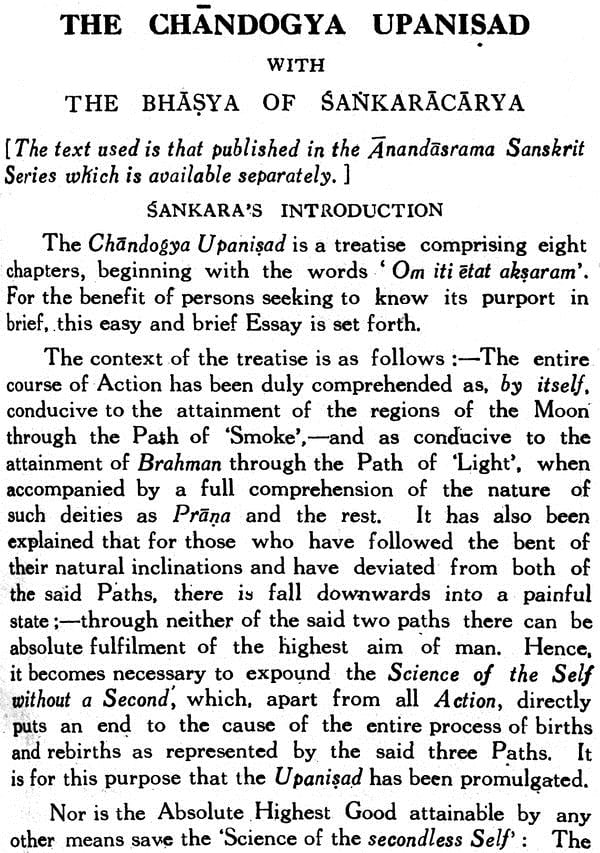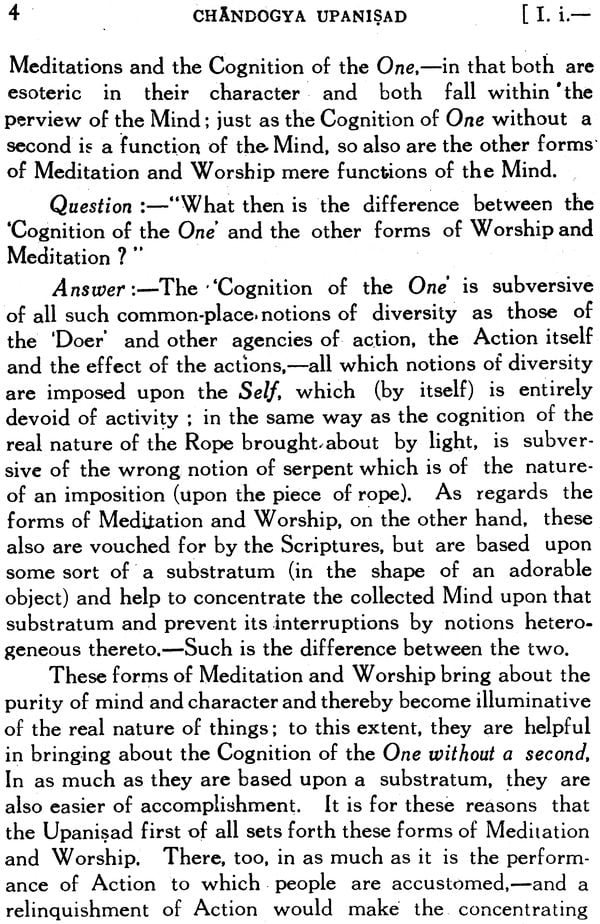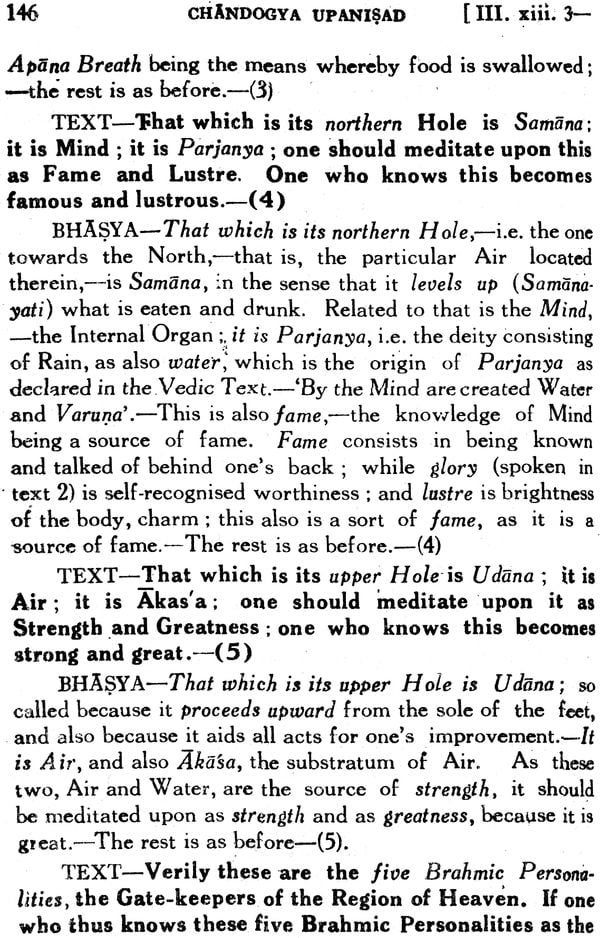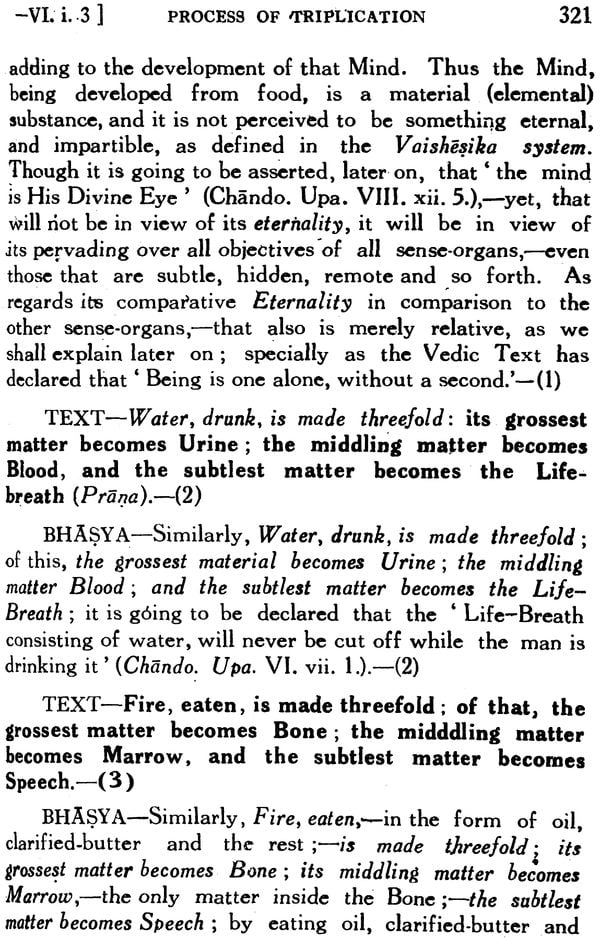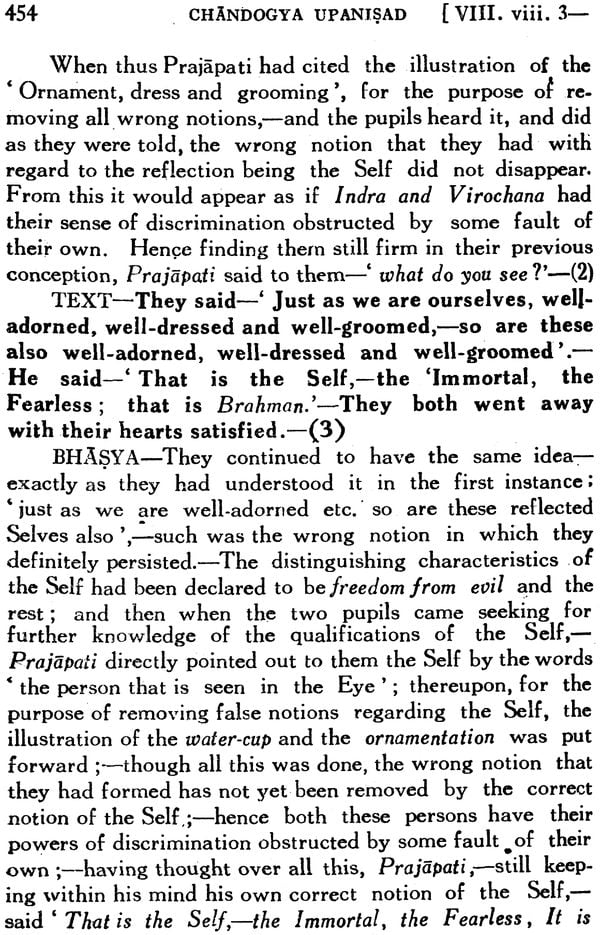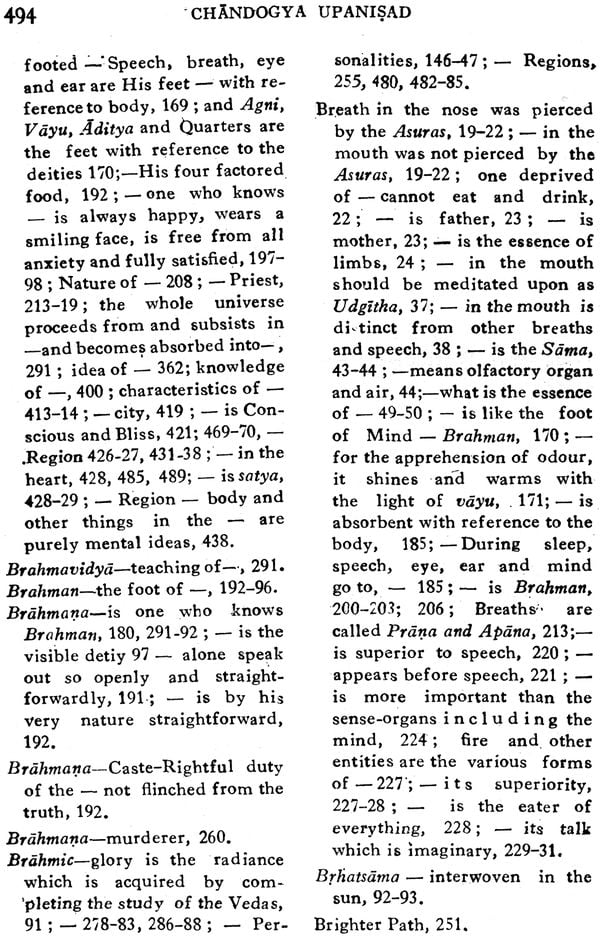
The Chandogyopanisad (A Treatise on Vedanta Philosophy with Commentary of Sankara (Shankaracharya))
Book Specification
| Item Code: | IDF301 |
| Author: | Dr. Sir ganganatha Jha,Dr. Umesha Mishra |
| Publisher: | Chaukhamba Sanskrit Pratishthan |
| Language: | Translated into English |
| Edition: | 2005 |
| ISBN: | 8170842840 |
| Pages: | 529 |
| Cover: | Hardcover |
| Other Details | 7.2" X 4.9" |
| Weight | 540 gm |
Book Description
The present volume contains the English translation of the Chandogya Upanisad along with the Bhasya of S'ankaracaya by the great teacher of Vedanta, the late Mahamahopadhyaya Dr. Sir Ganganatha Jha. Dr Jha had translated both the text and the Bhasya as early as 1899 and they were published from Madras. At the request of Dr. N. G. Sardesai, Proprietor of the Poona Oriental Book Agency, Dr. Jha revised the translation in 1935. Due to his weak health he could not correct the proofs of the whole of the book himself and handed over the work to me after a short time. The editing work was complete sometimes in October 1940, and had Dr. Jha been in good health, the book would have been published long before along with an Introduction from his own pen. He was anxious to write the Introduction himself as he wanted to present to the readers what actually S'ankara himself has said about this Upanisad. But unfortunately, he could not be spared to fulfil his last wishes. So the work had to be entrusted to me as was desired by Dr. Jha himself. As I have had enough opportunity to sit at his feet and know his thoughts very closely, I could understand what he wanted to include in his Introduction. So I have done my duty by writing an Introduction to this work and now, it is for the readers, in the absence of that great teacher, to say how far my efforts are successful. With these few words I proceed with the Introduction.
The earliest and most authentic record of Indian thought and culture is found treasured up in the Vedas. The term' Veda', derived from the root 'Vid' to know, means 'knowledge'. This knowledge is the Divine Revelation and has been rightly called the 'Divine Eye' and so, it is infallible and imperishable. The great sages of the past had visualised this Divine knowledge as the result of their austere penances. It is this eternal light which illumines the Path in every sphere of our life. It has been identified with the Absolute, called Brahman, where- from all the activities of the universe have sprung up. It is not the composition of any human being. Either God is the author of the Veda, as the Naiyayikas hold, or it is as much eternal and real as God Himself and which has revealed itself to the great Rsis of the past. This has been, therefore, handed down from generation to generation through verbal transmission, wherefore it is also called S'ruti ; and with a view to preserve its chastity the Vedic teachers did not like the idea of putting it down in black and white. But due to various reasons it became necessary, in course of time, to have the entire Vedic literature in writing.
The entire Vedic literature may be roughly divided into two broad heads-Karma-kanda and Jnana-rana. The former deals with the sacrificial rites and rituals, while the latter confines itself to the adhyatmika aspect. The generally known divisions of it are (1) Samhitas, that is, collections of hymns, prayers, incantations, sacrificial formulas etc; (2) Brahmanas, which mainly deal with sacrificial rites and ceremonies, and (3) Ararzyakas and Upanisads, The Aranyakas are like appendices to the Brahmanas and they contain everything which was of a secret, mysterious nature and spelt danger to the uninitiated, and which, for that reason, might only be taught and learnt in the forest. "The main contents of these are no longer rules for the performance of the sacrifices and the explanation of ceremonies, but the mysticism and symbolism of sacrifice, and priestly philosophy" (Winternitz-History of Indian literature, Vol. I. p. 233). Upanisads deal with the philosophy of the Absolute and also the upnsana.
Upanisads and such portions of the Aranyakas as deal with the Jnanakanda form the very background of all the later philosophical literature. The various problems of the philosophical thought, which came to be associated with the different schools of Darsana in later period, are found scattered here and there in these works, as common property of all. So, it is from these that the philosophical sutras of all the systems of thought have been formulated (vide-Umesha Mishra-Back-ground of the Badarayana Sutras, Kalyana Kalpataru, Vol. 111. 1, 1936). In fact, the entire philosophical literature, from the sutra-period down to the present day, is based on these works. But it should not be forgotten that although these works contain problems of every sort, yet they are pot unconnected. The central theme of this portion of the literature, namely Brahman, the Absolute, in all its aspects and such other allied problems as, the Individual Self, its relation with the Supreme Self, the nature of Reality, the universe etc., is always before the mind in course of the treatment of every other topic. It is, therefore, that the term 'upanisad' has been explained so as to indicate directly or indirectly the same Brahman (vide Shankara's Introduction to his Kathopanisad-Bhasya). As this portion forms the last part of the Vedic literature in the chronological order, it has been rightly called 'Vedanta', i.e. ‘the end of the Veda’ So it is one of the three Prasthanas of the Vedanta, It has been variously called Brahmavidya Rahasya (the secret) etc.
The Samhitas are divided into four-Rk-Samhita, Sama-Samhita, Yajus-Samhita and Atharvana-Samhita. The Rk-Samhita is called the Rgveda. It contains mantras, called rks which are in the form of prayers and praises of Gods. The Sama-Samhita is the Samaveda dealing with the melodious chants in praise of Gods. The Yajus-Samhita is called the Yajurveda which deals with the sacrifices and the sacrificial formulas. The Atharvana-Samhita is the Athervaveda which deals with the various Arts and Sciences even including magic.
To each of these four Samhitas are attached different Brahmanas, Aranyakas and Upanisads. As all our activities are guided by the rules laid down in the Karmakanda-section of the Veda and as the Karmakanda-portion of each Veda differs from one another in details, the Brahmanas, also separately grouped themselves as the followers of one or the other Veda accordingly. Thus, to the Rgveda are attached the Aitareya-Brahmana, the Kausitari or the Sankhyayana. To the Aitareya-Briihmana belongs the Aitareya-Aranyaka, the third part of which is called the Aitareya-Upanisad. Similarly, to the Kausitaki-Brahmana belongs the Kausitaki-Aranyaka of which the chapters 3 to 6 are designated as the Kausitaki Upanisad.
To the Samaveda belong several important and unimportant Brahmanas. The important Brahmanas are-(1) the Talavakara, also called the Jaiminiya-Brahmana, (2) the Tandya-Maha-Brahmana, also known as the Pancavimsha and (3) the Chandogya - Brahmana ; while the (4) Samavidhana, 5) the Devatadhyaya, (6) Vamsa, (7) Arseya etc. are the minor and unimportant Brahmanas.
To the Talavakara-Brahmana belongs the Talavakara-Upanisad, which, later on, came to be called Kena-Upanisad. Of the Chandogya-Brahmana, the first two chapters alone are called Brahmana, while the remaining eight chapters constitute what is called the Chandogya-Upanisad.
The Yajurveda has two main divisions-Krsna-Yajur-veda and Shukla-Yajurueda. The farmer has three recensions (Shakhas)-Kathaka, Maitrayani and Kapisthala. To the Krsna-Yajurveda belongs the Taittiriya-Brahmana, which has the Taittiriya-Aranyaka attached to it. The Taittiriya-Aranyaka consists of ten sections the last four sections whereof constitute the three Upanisads, that is, the seventh Prapathaka is called the Samhiti-Upanisad, the eighth and the ninth sections constitute the Varuni-Upanisad, while the tenth constitutes the Narayani, also called the Yajniki or the Maha-Narayana Upanisad. The last three sections of Book III of the Taittiriya-Brahmana and the first two Prapathakas of the Aranyaka appear to follow the Katha recension. The other Upanisads of this Veda are (i) Katha, (ii) Svetasvatara and (iii) Maitrayani.
| INTRODUCTION | i-xiv |
| CONTENTS | xv-xvi |
| DISCOURSE I | 1-69 |
| S'ankara's: Introduction | 1-4 |
| Meditation of 'Om' | 5-17 |
| Contempletion of 'Om' | 18-39 |
| Meditation of Udgitha | 40-69 |
| DISCOURSE II | 70-121 |
| Meditation of the whole saman | 70-121 |
| DISCOURSE III | 122-175 |
| Meditation of the sun | 122-150 |
| Meditation of qualified Brahman | 151-156 |
| Meditation of sacrifice as man | 157-168 |
| Meditation of manes - Akasa | 159-175 |
| DISCOURSE IV | 176-219 |
| Meditation of Vayu and Prana as Brahman | 176-193 |
| Meditation of sixfold Brahman | 193-198 |
| Philosophy of Fires | 199-219 |
| DISCOURSE V | 220-290 |
| Three paths for the Householders | 220-224 |
| Philosophy of the Breaths | 225-240 |
| Process of Birth and Rebirth | 241-272 |
| Philosophy of Vais'wanara Fire | 273-290 |
| DISCOURSE VI | 291-365 |
| Philosophy of Being | 291-309 |
| Progress of Triplication | 309-327 |
| Philosophy of Being | 328-365 |
| DISCOURSE VII | 366-412 |
| Philosophy of name and other lower things | 366-374 |
| Philosophy of Mind | 375 |
| Philosophy of Will | 376-378 |
| Philosophy of Intelligence | 379-380 |
| Philosophy of Contemplation | 391-382 |
| Philosophy of Learning | 383-384 |
| Philosophy of Food | 385-386 |
| Philosophy of Water | 387-388 |
| Philosophy of Akas'a | 389-390 |
| Philosophy of Memory | 391-392 |
| Philosophy of Spirit | 392-400 |
| Philosophy of Bliss | 401-402 |
| Philosophy of Infinite | 403-406 |
| Philosophy of Self | 407-412 |
| DISCOURSE VIII | 413-490 |
| Investigation into Nature of Brahman | 413-414 |
| Philosophy of Being | 415-416 |
| Philosophy of Inner Akas'a | 417-419 |
| Philosophy of Self | 420-422 |
| Region of the Fathers | 423-425 |
| Philosophy of Self | 425-432 |
| Importance of Celibacy | 433-440 |
| Description of Arteries | 441-444 |
| Description of passing spirit | 445-446 |
| Search after Self | 446-447 |
| Philosophy of Self | 448-490 |
| Index | 491-513 |
